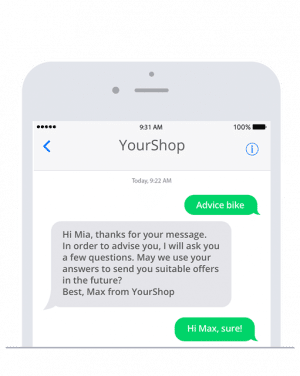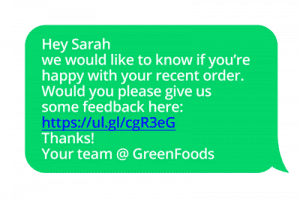Collecting zero-party data – Our examples
There’s no question that a personal connection with your customers makes communication easier. But how exactly can you use SMS to collect zero-party data? Basically, there are hardly any limits to your imagination. However, it is also clear that in this case SMS are most powerful when combined with other media or used to have an authentic conversation. If you want to use the latter variant, you should definitely book your own inbound number.
We would like to show you some examples of how you can collect zero-party data via SMS from your customers. No matter which variant you choose, always tell your customers beforehand that and how you plan to use the data. You should also use SMS very selectively, because the personal touch of SMS also means that too many messages are more likely to be perceived as annoying.
Especially in cases where you send an interactive part, you should make sure that it is kept as short and simple as possible. After all, you don’t want a scientific paper from your customers, but useful information. When in doubt, split your questions into two separate messages that are sent with some time in between.
Send out surveys…
Surveys are great for collecting a wide variety of data, from user experience on your website and during the checkout process to interest in future offers. If you want to collect zero-party data, for example, you can send surveys about how your product is used. This will help you learn what your customers like about your products and what you can do to improve your offering.
…or a quiz
Similar to surveys, but more exciting for customers: Send the link to a quiz or conduct a quiz via SMS. Again, there are numerous options:
How much do you know about healthy eating? How well do you know your bike? Can you cook the perfect steak?
Many quiz forms work well for asking for personal data and fit seamlessly into your content marketing. Of course, it also makes sense to offer a quiz that has overlap points with consultation, such as “Which backpack suits me best?” is you sell backpacks and other bags.
Offer consultations via SMS
Probably one of the best and most comprehensive ways you can choose when using SMS to collect zero-party data is to offer advice and consultations via SMS.
This option combines many advantages. You offer a service that your competitors probably don’t offer, you learn firsthand what’s really important to your customers, and you help them find the product that is perfect for them.

